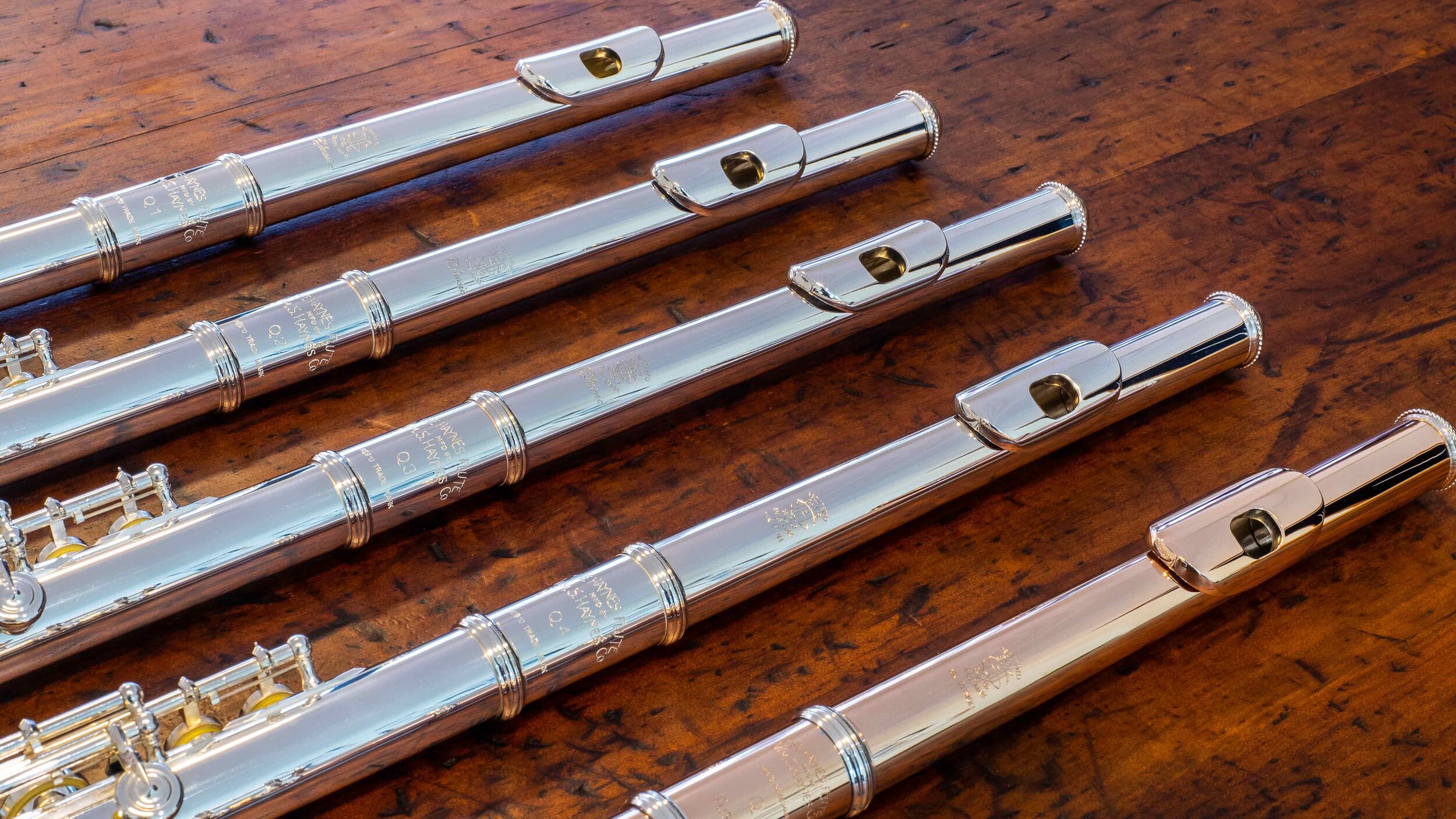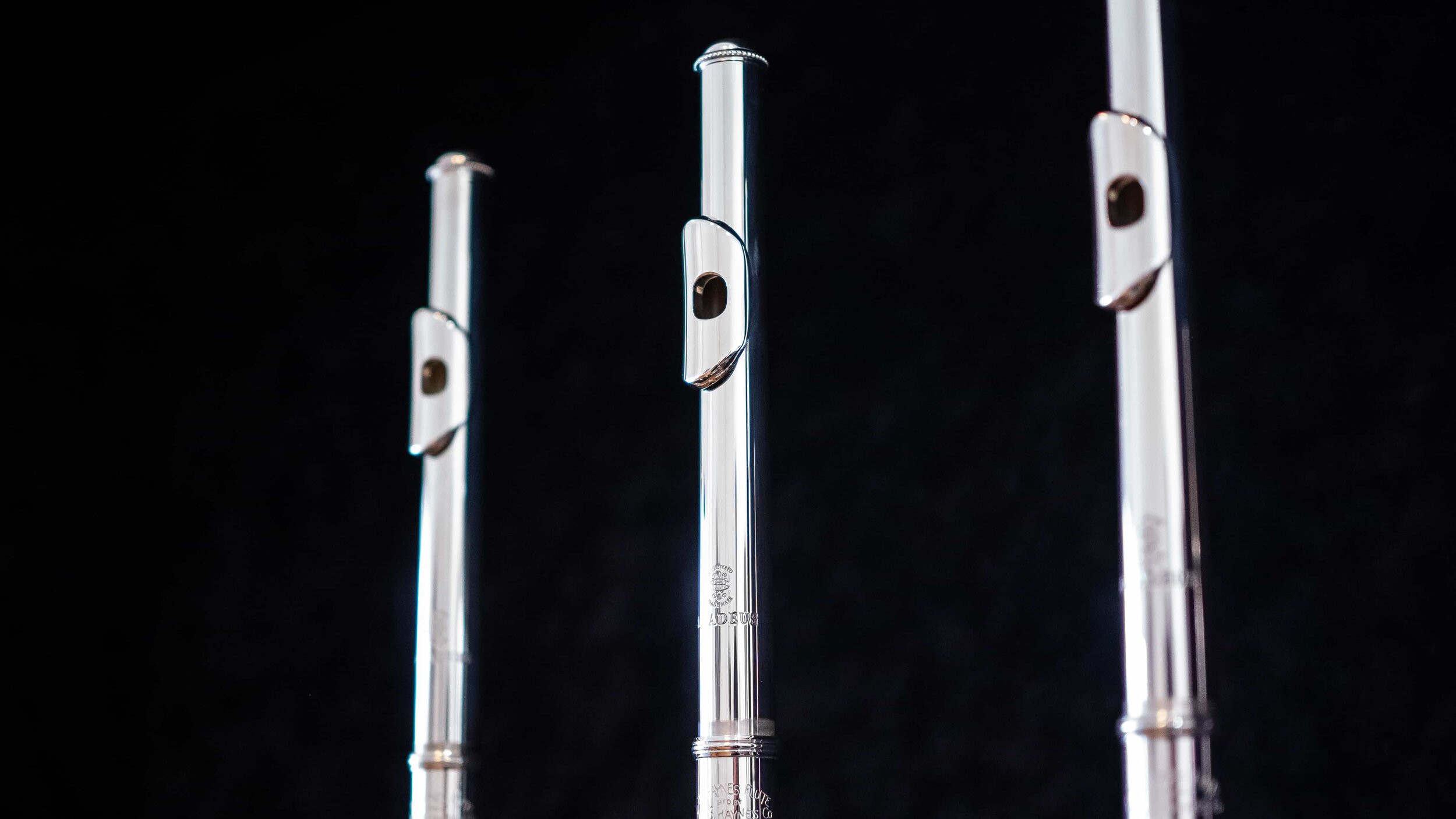
Finding the Right Flute
-
Student Flute
The Student range of instruments is generally manufactured and assembled quickly and with least concern for final finish. The low price of this range of instruments is basically achieved by minimal labour time. Despite this, many student brands are now made so precisely that a very good result is achievable.
The basic Student flute is made of a brass tube with silver plating. Silver plating gives a better sound over nickel, which can be too metallic sounding and slippery to hold. Variations such as split E mechanism, C or B foot, open or closed holes and offset G are usually available as well. At FLUTES & FLUTISTS, we recommend students to start learning on a flute equipped with a split-E mechanism and Offset G and stock flutes with these features as standard.
-
Intermediate Flute/Semi-Professional Flute
The Intermediate range starts with a solid silver lip plate with silver plated head, body and keys; then progresses to an entirely solid silver head with silver plated body and keys; and finally solid silver head and body but still with silver plated keys. Good quality Intermediate flutes often come with a hand-finished headjoint but the rest of the body and keys are still factory produced.
Semi-Professional flutes share a lot of similarities with Intermediate flutes in terms of the materials used, however even though some of the parts may be machine made, the flute is ultimately assembled and finally finished by hand.
This final ‘hand-finishing’ results in an instrument that plays as well as possible with the maximum response and performance.
-
Professional/Prestige Flute
The Professional level instruments are made almost completely by hand. Some parts may be made with the assistance of machinery, however highly skilled artisans are involved in every step of the production process. This is the reason why the cost of these instruments is so high, as it takes a significant amount of skill and several months to craft an entire flute.
Professional flutes are made from a wide range of materials, from sterling silver (92.5%), Britannia silver (95.8%) and pure silver (99.7%) to various rare woods, gold and platinum more commonly found in the Prestige flutes. Other construction options include seamed or drawn tubing, soldered or drawn tone-holes, split E mechanism, C or B footjoint, C# trill key, offset or inline G and different tubing thicknesses (more detailed explanation for some these options can be found below).
What Kind of Player Are You?
If you are a beginner, then you will more than likely be choosing something in the student range. A well adjusted, good quality, basic student flute is good for anyone playing up to about AMEB Grade 3. Beyond that is certainly also possible, but it is arguably holding the player back at that point.
You will achieve a better quality and more variation to your tone with a handmade headjoint. Craftsmanship, design and how they suit the player are the most important factors here, not necessarily more silver content. However, you will get to a point where no matter how good the headjoint is, the body will not be good enough. By that stage, your playing skill will no doubt be developed to the point where you clearly notice the difference by yourself. In fact, you will probably notice it well before then if you are producing a good tone.
The difference in moving up to the hand-finished range is that the instrument will be well designed and very precisely made, resulting in far superior sound, more even connection throughout the entire range, clean articulation, better dynamic range and a greater range of colours.
You may find that starting with an intermediate model is a good idea, because if you are reasonably serious about your development, you will save money by not having to upgrade after a year or so. Also, in the meantime, you will benefit from learning and playing on a superior quality instrument. Most people start with a student flute and move up when they clearly notice the difference, and consequently spend more money.
Which Specifications Do You Need?
There are several options when purchasing your first flute, but for most beginners the best choice is an all silver plated, covered holes, offset G, C foot model. Silver plated is best. Nickel plated flutes are slightly cheaper but not worth it because they are harder to hold if the player perspires, and in addition the tone is inferior because it is harder sounding.
Most student flutes in Australia are offset G which is preferable, as it means the player has less distance to stretch the left hand ring finger than on an inline model. Closed holes are usually preferable for beginners, although if the player can comfortably reach and cover all the holes, then the open hole flute is recommended. However, because it is slightly more complicated to make, the open hole flute is a little more expensive to purchase and service.
Most beginner flutes have a C foot. The B footjoint has one more key added to the bottom of the flute making it slightly longer and heavier. The tone is a little darker from about G down. For most beginners this addition is not at all necessary and once again will add to the price.
The curved head is of great benefit and highly recommended for children approximately under the age of 10. It causes the flute to be held much closer to the player’s body and significantly reduces the player’s spine being twisted. Stretching to reach the keys by little arms is undesirable from a postural and physical development point of view. Technological developments and innovations by ALTUS and JUPITER have given birth to the Wave Flutes which offer several advantages over the previous curved headjoint models.
Probably the most difficult option to decide on, though, is that of the split E mechanism although these days it is almost universally adopted. This extra piece of key-work only affects the third register E and causes the proper opening of the keys for that note resulting in correct tuning and ease of sound production. This feature is now available on almost all student model flutes, however it adds significantly to the price. The issue becomes one of deciding whether playing top E with greater ease is worth the additional cost.
Almost all professionals now order or play with a split E, which is some indication of its usefulness and significance.

Need Further Information?
Download this free 21 page COMPLETE GUIDE for more detailed information on how to choose a flute, or contact us and we will be more than happy to answer all of your questions!


